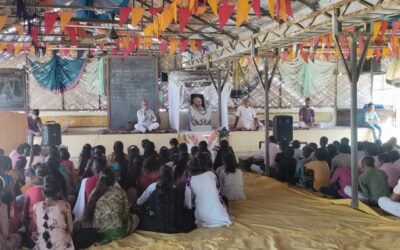Access to healthcare is a necessity to all communities. However, the diagnoses, treatment and recovery vary as widely as the communities themselves. To aid a human body heal itself is considered a noble cause, and the need for it is only increasing with the population and change in the consumption patterns of the society. At Swasthya Swaraj, we work at the primary health level with people, and somewhat represent modern medicine and theory. However, even before the organisation started, there have been stakeholders in the healthcare sector, most prominently the Guru Guniyas (faith healers) and the self-employed mobile “doctors”, who have been working with people since a long time. While the intentions of all the three healthcare facilities might be noble and true, there are many instances in which the practice of these systems contradict each other and even cause problems.

Guru Guniyas or traditional faith healers are as old as the community itself. Almost all villages in the regions that we work with, belong to the Kandha tribe. Each village has a ‘Guru’, who is an extremely knowledgeable person and takes care of the healthcare of the people. This traditional knowledge has arisen out of generations of treating illnesses and developing cures. It has tremendous amount of respect in the community. This practice also deeply connects with their cultural identity, which they are proud of and want to conserve.
While their methods work well and can be traced through scientific theory, there are times when some diseases can’t be treated, and the healers resort to superstition and religious beliefs. This can sometimes be a burden for the patients as they have to spend a lot of money on rituals and animal sacrifice, and the entire family has to stop work and attend the processions. Following that, if it is not effective, then the Guru just tells the families to let the patient be by themselves, as anything anymore cannot be done.
The self-employed mobile “doctors”, also known colloquially as “Bangali” are self-proclaimed doctors and distribute medicines to the local population. They are not from the community, and many have come from different parts of India to set up temporary camps as they travel between villages. They carry strong general medicines with them, which can broadly cure the prevalent diseases in the community. For example, they carry Artemether injections, a strong dose that is used to treat Malaria, a deadly disease that affects most of the community members.
However, due to the lack of basic training, these doctors can only respond to basic symptoms, and in many cases, the symptoms do not require such strong medicine. In some instances, even patients with a mild fever due to the weather are given Artemether injections and that leads to complications. Also, the standards of hygiene and sanitation that are required while giving injections are not always followed which causes infections, inflammation and pain.
These doctors undoubtedly have the most impact on the people, as they take modern medicines where nobody else is willing to, in the deepest and most difficult to access regions. However, they have developed a standard of using injections for all the diseases that they encounter. As the medicines work well, in the short term at-least, people have started believing that only injections are real medicines and tablets or syrups are either too slow or have no effect at all. They also sell the injections at a high rate; but, it still has enormous demand because the villagers don’t have to travel anywhere and have a quick treatment which works well at the moment.
Finally, there is Swasthya Swaraj, which runs two primary health clinics in village clusters. We employ certified doctors and do not just work on treatment, but prevention and sustainability as well. Swasthya Swaraj wants to make healthcare a community-run initiative and has developed a system which involves people from each village, and their participation is crucial to bring about any change.
There are four levels of networks in the system, the most grounded one being women representatives from each village known as “Swasthya Sathis”, whose main duty is to go to each household in their village, suggest people to consume food with adequate nutrition, and send them to the hospital for regular check-ups or if there is an emergency. This system works well but there is a feeling amongst people that the organisation belongs to outsiders, and is not as effective as the other aforementioned alternatives.
Also, due to the procedures that we follow, patients on average spend more time in the clinics, which is seen as a hassle because the villagers have a lot of work all year round. In some cases, patients even have to be transferred to the closest town, Bhawanipatna, which most people are not at all comfortable with.

When all three of these systems work at the same time, there are many conflicts that we can notice, due to the different incentives, techniques and reach that each party has. For example, Swasthya Swaraj receives patients on a regular basis, who have an abscess due to non-sanitised syringes. When we travel to villages, many people who refuse to take treatment as the Gurus have told them that there are spirits in the clinics.
However, we have realised that all the healthcare programs have their positives, and we can work together to achieve better outcomes. We have conducted training for the Guru Guniyas, which should allow them to refer the patients to the hospital if they feel like they cannot handle the situation. Similarly, we are planning to provide solitary doctors with adequate medicines and tools to maintain basic safety in their work.
We cannot work against the other stakeholders and instead have to work with them. The most important thing is that when we approach them with a positive attitude, they are willing to listen, as ultimately, we all want to work to better ourselves, even if some are looking out to increase their profits.




0 Comments